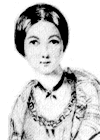Florence Nightingale

May 12, 1820 - August 13, 1910
Written by Cynthia Audain, Class of 1998 (Agnes Scott College)
Florence Nightingale is most remembered as a pioneer of nursing and a reformer of hospital sanitation methods. For most of her ninety years, Nightingale pushed for reform of the British military health-care system and with that the profession of nursing started to gain the respect it deserved. Unknown to many, however, was her use of new techniques of statistical analysis, such as during the Crimean War when she plotted the incidence of preventable deaths in the military. She developed the "polar-area diagram" to dramatize the needless deaths caused by unsanitary conditions and the need for reform. With her analysis, Florence Nightingale revolutionized the idea that social phenomena could be objectively measured and subjected to mathematical analysis. She was an innovator in the collection, tabulation, interpretation, and graphical display of descriptive statistics.
Florence Nightingale's two greatest life achievements--pioneering of nursing and the reform of hospitals--were amazing considering that most Victorian women of her age group did not attend universities or pursue professional careers. It was her father, William Nightingale, who believed women, especially his children, should get an education. So Nightingale and her sister learned Italian, Latin, Greek, history, and mathematics. She in particular received excellent early preparation in mathematics from her father and aunt, and some references also claim she was tutored in mathematics by James Sylvester (although there seems to be no documentary evidence of this). In 1854, after a year as a unpaid superintendent of a London "establishment for gentlewomen during illness," the Secretary of War, Sidney Herbert, recruited Nightingale and 38 nurses for service in Scutari during the Crimean War.
During Nightingale's time at Scutari, she collected data and systematized record-keeping practices. Nightingale was able to use the data as a tool for improving city and military hospitals. Nightingale's calculations of the mortality rate showed that with an improvement of sanitary methods, deaths would decrease. In February, 1855, the mortality rate at the hospital was 42.7 percent of the cases treated (Cohen 131). When Nightingale's sanitary reform was implemented, the mortality rate declined. Nightingale took her statistical data and represented them graphically. She invented polar-area charts, where the statistic being represented is proportional to the area of a wedge in a circular diagram (Cohen 133).
As Nightingale demonstrated, statistics provided an organized way of learning and lead to improvements in medical and surgical practices. She also developed a Model Hospital Statistical Form for hospitals to collect and generate consistent data and statistics. She became a Fellow of the Royal Statistical Society in 1858 and an honorary member of the American Statistical Association in 1874. Karl Pearson acknowledged Nightingale as a "prophetess" in the development of applied statistics.
Read about the mathematical education in the life of Florence Nightingale in an article by Sally Lipsey that appeared in the Newsletter of the Association for Women in Mathematics.
Watch a video on "The Lady With a Data Visualization" from the "Joy of Stats", The Open University, England.
References
- Cohen, I. B. "Florence Nightingale," Scientific American, 250 (March 1984),128-137.
- Cohen, I.B. The Triumph of Numbers: How Counting Shaped Modern Life, W. H. Norton, 2006. Chapter 9 is devoted to Florence Nightingale. [Read excerpts from Google Book Search]
- Sandra Stinnett. "Women in Statistics: Sesquicentennial Activities," The American Statistician, May 1990, Vol 44, No. 2, 74-80.
- Kopf, E.W. "Florence Nightingale as a Statistician," J. Amer. Statist. Assoc., 15 (1916), 388-404.
- Nuttall, P. "The Passionate Statistician," Nursing Times, 28 (1983), 25- 27.
- Grier, M.R. "Florence Nightingale and Statistics," Res. Nurse Health, 1 (1978), 91-109.
- Lipsey, Sally. "Mathematical Education in the Life of Florence Nightingale," Newsletter of the Association for Women in Mathematics, Vol 23, Number 4 (July-August 1993), 11-12.
- Wadsworth Jr., Harrison, Kenneth Stephens and A. Blanton Godfrey, Modern Methods for Quality Control and Improvement, Wiley & Sons, 1986. Discusses the history of graphical methods in quality control and F. Nightingale's contributions.
- Florence Nightingale Museum website
- MathSciNet [subscription required]
- Biography at the MacTutor History of Mathematics Archive
